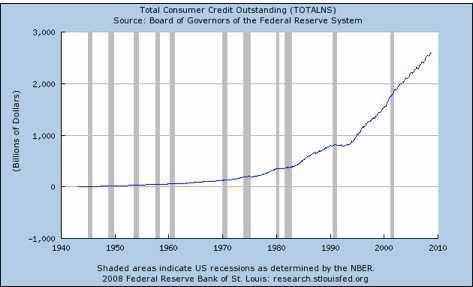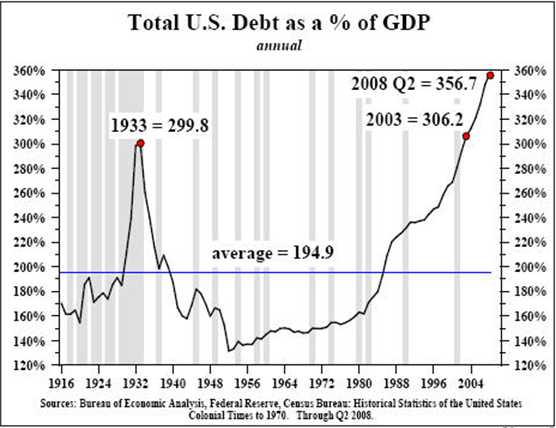Audacity of Reality
Hope will not get the United States out of our current predicament. It took decades to get to this point and it will take decades to extract ourselves from this debt induced disaster. A few charts will hammer home the reality of the U.S. situation.
The chart above shows that we enter this financial crisis with total U.S. debt at record levels as of the end of the 2nd quarter of 2008. Since that time we’ve added billions more in debt. At the end of the 3rd quarter, total U.S. credit market debt was $51.8 trillion. The proposed stimulus package of $1 trillion combined with declining GDP will result in the percentage exceeding 400% of GDP by the end of 2009. Japan entered their “lost decade” with total debt of 260% of GDP. Therefore, they had more leeway to expand government debt. Their biggest advantage over the U.S. was that they did not have to convince foreign nations to buy their debt. With large trade surpluses and high savings rates, the debt was purchased by their own citizens.

American consumers enter this economic downturn as the most indebted people on earth. The materialistic frenzy of the last two decades has left the American consumer saddled with $2.6 trillion of credit card and auto loan debt. Japanese consumers entered their “lost decade” with personal savings rates of 12% annually. Japanese consumers were able to utilize savings to pay down their debt throughout the 1990’s. The American savings rate, which was 12% in 1980, fell below zero in 2006. It has since inched up to 2% in recent months. There are over 300 million credit cards in use today in the U.S. The average American with a credit card is carrying debt of $16,635, according to Experian. With unemployment skyrocketing, wage growth stagnant, and home equity extraction a thing of the past, American consumers are rationally paying down debt. The result is devastating the economy. When 72% of the economy is dependent upon consumers borrowing and spending, deleveraging by consumers will bring the economy to its knees.
The crux of our current crisis is housing, just as Japan’s crisis was related to real estate. Irrational exuberance, as described by Yale economist Robert Shiller, led to the most outrageous housing boom in U.S. history. It was aided and abetted by greedy investment bankers, sleazy mortgage brokers, dishonest appraisers, Alan Greenspan, clueless ratings agencies, and Congressmen in the back pocket of Fannie Mae and Freddie Mac. Delusional home buyers were convinced that flipping houses was a road to riches. Instead, they’ve skidded off the road and fell into a bottomless ravine.

The amazing thing about reversion to the mean is that it always ensues, eventually. The sad thing is that people keep praying that reversion won’t happen this time. Home prices have tracked very closely to CPI for over a century. The housing boom from 2000 to 2006 was so off the charts that people can not come to grips with the dramatic fall that is needed for reversion to the mean to work its mathematical magic. Politicians want house prices to stop falling in the worst way. There is nothing they can do to stop prices from falling to their natural long term equilibrium. Government intervention will only prolong the time frame and delay the recovery. Home prices in Japan fell for 14 years before bottoming in 2004. Home prices have been dropping in the U.S. for 3 years. How does another decade of home price declines grab you? It is entirely possible if the government tries to intervene in the free market process of supply, demand and price.
Bitter Medicine Needed
I know that many Americans are looking for President Obama to solve this crisis in a sound bite way, with no pain and no sacrifice. They want this to end like an episode of CSI with the murder solved within a one hour time slot. Instead we have a Jonestown massacre that will never be fully understood or solved. Was it mass murder or mass suicide? We have experienced a mass hysteria of debt accumulation by consumers, banks, corporations and the government. There is no easy way out. The debt must be paid off and/or written off.
The politically unpopular steps that need to occur are as follows:
- From an overall standpoint, when you have entered a recession due to fiscal irresponsibility, you don’t get out of it by becoming even more fiscally irresponsible.
- Housing prices need to drop another 15% to 20% to reach fair value. This will result in more foreclosures. When prices fall far enough, the houses will sell and inventories will fall. If you cannot afford the payment on your home, you should become a renter. Not everyone should own a home.
- The government and Federal Reserve need to shine a bright light on the bad debt within the financial system. The collateral or lack thereof backing up the government loans needs to be revealed by Treasury and the Federal Reserve. Covering up the worthlessness of these assets is contributing to the frozen system.
- The remaining mega-banks that have caused this crisis need to be put out of our misery. The shareholders and bondholders of Citigroup (C), Bank of America (BAC), Goldman Sachs (GS), Morgan Stanley (MS) and any other insolvent banks need to be wiped out. The bad banks should go out of business. The prudent banks that did not take financial system destroying risks should be allowed to succeed based on their merits.
- Failed companies with failed strategies must go bankrupt. If the American auto industry is propped up by taxpayer money, the capitalist process of rationalizing manufacturing capacity to final demand will never happen. Allowing companies to fail brings about restructuring and the remaining healthy companies buy the good assets.
- Only infrastructure projects that benefit the citizens of the country should be undertaken. These would include water pipe replacement, electrical grid upgrades and repairing structurally deficient bridges. If the money is spent on worthless make work projects, good investments will be crowded out.
- Tax rebate checks are just a redistribution of wealth from future generations to the spendthrift generation of today. A tax decrease today that is borrowed is a tax increase on our children. They will not stimulate spending.
- Keeping interest rates at zero in an effort to force savers to borrow and spend is penalizing the frugal to benefit the profligate. Borrowing our way out of a debt crisis will never work.
- Consumers should be encouraged to pay down their debt loads and increase their savings rate. The sooner this can be accomplished, the sooner the country can resume growth. Savings will lead to investment.
- The median 401k balance was $18,942 at the end of 2007, with 39% of workers having a balance below $10,000. Approximately 8,000 Americans turn 65 every day. By 2012, 10,000 people will turn 65 per day. Twenty percent of the U.S. population will be over 65 by 2030. An aging population with virtually no retirement savings must increase their savings and cut their consumption dramatically.
- The CEOs who brought down the entire financial system need to be brought to justice. Angelo Mozilo, Dick Fuld, Charles Prince, Jimmy Cayne, John Thain, Stanley O’Neal, Ken Thompson, Robert Steele, Martin Sullivan, Hank Greenberg, Richard Syron, Daniel Mudd, Kerry Killinger, Raymond McDaniel, Terry McGraw and probably a few I’ve missed, need to be investigated and prosecuted for lying to shareholders about the true financial condition of their firms.
- Fannie Mae (FNM), Freddie Mac (FRE), and AIG are wards of the state. The U.S. taxpayer is obligated to pay $150 billion to AIG and $200 billion to Fannie Mae and Freddie Mac. AIG is using these funds to undercut other insurance companies in pricing insurance policies. This will result in insurance companies that did nothing wrong being put out of business by the government supported goliath that almost brought down the financial system. Fannie & Freddie are being pushed by Barney Frank and his distinguished colleagues in Congress to provide more 3% down loans to people who won’t pay them back. The Fed then buys the loans and pretends they are good collateral, while not revealing the true value to the public. Sounds like good policy to me. These companies need to be euthanized and any decent assets sold to viable companies.
- Moody’s and S&P should be banned from the rating business. They proved that a AAA rating could be bought. Pension plans, governments, companies, and individuals relied on their ratings. They colluded with the investment banks and must be punished. Their monopoly needs to be ended.
- The SEC needs to be disbanded. We need to push the start over button. They are in bed with Wall Street. They are unable to enforce their vast array of regulations, ignore proof of Ponzi schemes, and are a revolving door to top Wall Street jobs. The organization has failed miserably. An agency that does not work needs to be scrapped.
The solutions described above are too politically difficult to implement. There are not enough courageous people in Washington DC to do what is right and necessary. They want a way out that is easy and painless, like the Staples commercial. The easy solution is to print a trillion dollars, hope the Chinese, Japanese, and oil exporting countries continue to buy our debt, and try to inflate our way out of this mess. And that is just what will happen. The following steps will be taken by our cowardly, short term, blundering politician leaders:
- Despite the fact that this crisis was caused by the Federal Reserve keeping interest rates too low for too long, investment banks leveraging their balance sheets 40 to 1, banks marketing 120% loan to value mortgage loans on overpriced houses, consumers borrowing at obscene levels from their overpriced homes and credit card companies handing out credit cards like candy, the solution will be to keep interest rates at zero, force banks to lend, prop up insolvent banks, stop foreclosures, and give consumers tax rebates so they can resume spending.
- The Democrats controlling Congress will use the remaining $300 billion of TARP funds to allow people who are living in houses they can’t afford to not be foreclosed upon. They will encourage bankruptcy judges to reduce mortgage balances. This will result in a reduction in mortgages available to credit worthy people with higher rates to cover the possibility that a judge could adjust the loan amount in the future.
- With banks not willing to lend, the government bureaucrats running our financial industry will force Fannie Mae and Freddie Mac to make additional bad mortgage loans to unworthy borrowers and guarantee more bad loans from other unworthy borrowers. The Federal Reserve will then buy these bad loans at full price and hide them on their bloated balance sheet.
- Rather than letting the bad banks go bankrupt and allowing good banks to rise up and replace them, the U.S. taxpayer will continue to pump in hundreds of billions into these zombie banks for years before their toxic waste balance sheets are cleaned up. The “Bad Bank” created by the government will overpay for worthless assets and pretend that they will eventually recover the cost. This will be done because the people running the Treasury go to the same Manhattan cocktail parties as the bad bankers and Congressmen have their campaigns financed by these bad bankers.
- General Motors (GM), Chrysler and Ford (F) will come back to Congress in March with restructuring plans that are dead on arrival. They will explain that conditions have deteriorated and they need another $20 billion to keep going. The Democratic led Congress, who is beholden to the UAW, will give them our money. Plants and dealerships that need to close will remain in business.
- Whenever I hear the term “Shovel-Ready” projects, I’m reminded of a line by Paul Newman in Butch Cassidy and the Sundance Kid. “Don't ever hit your mother with a shovel. It will leave a dull impression on her mind." The U.S. taxpayers are about to be hit in the head with a shovel. The States say they have thousands of projects that are shovel-ready. If an infrastructure project is to the point where it is shovel-ready then it has already been funded. The infrastructure spending by the Federal government will just replace the funding that was already in place. This will produce zero stimulation.
- President Obama has vowed that there will be no earmarks. Who needs earmarks when the bill already has this much non-stimulating pork:
- $44 million for repairs at the Agriculture Department headquarters in Washington.
- $200 million to rehabilitate the National Mall.
- $360 million for new child care centers at military bases.
- $1.8 billion to repair National Park Service facilities.
- $276 million to update technology at the State Department.
- $600 million for General Services Administration to replace older vehicles with alternative fuel vehicles.
- $2.5 billion to upgrade low-income housing.
- $400 million for NASA scientists to conduct climate change research.
- $426 million to construct facilities at the Centers for Disease Control and Prevention.
- $800 million to clean up Superfund sites.
- $6.7 billion to renovate and improve energy efficiency at federal buildings.
- $400 million to replace the Social Security Administration's 30-year-old National Computer Center.
- The tax rebates of $500 for individuals and $1,000 for couples will sail through unopposed. Just as the previous rebate checks were used to pay off debt or saved, these rebates will not be spent. Therefore, we will have just transferred money from future generations to the current generation.
- The Federal Reserve will keep interest rates at zero, buy up bad assets from financial institutions, buy bad mortgages, buy Treasury bonds to artificially depress rates, and keep printing money until glorious inflation comes back to save the day. Everyone has faith that they will turn the spigot off in time. Their past record of seeing crucial turning points should give us all a sense of calm.
- Timothy Geithner has fired the first shot across the bow of China. He accused China of currency manipulation. Hopefully, this is just rhetoric. When you owe someone $500 billion and you need to borrow an additional $2 trillion in the next year, it isn’t too smart to piss the lender off. Whiffs of trade restrictions and tariffs are reminiscent of Smoot-Hawley and the Great Depression.
 Source: Wikipedia
Source: Wikipedia- Rather than scrapping the SEC, Congress will significantly increase their annual budget, hire more bureaucrats, and increase the regulations on businesses. Sarbanes Oxley has cost U.S. companies in excess of $1 trillion and has done nothing to make accounting more transparent. The lack of transparency is the main reason the financial system remains frozen today.
- Congress will hold hearings where they embarrass CEOs, but will not prosecute anyone. They know that they are just as culpable in the financial disaster and would not want to shine too bright a light on the subject.
- The single biggest dilemma facing President Obama is something he has absolutely no control over. The American public has been traumatized over the last year. They have been misled by the government, lied to by Wall Street, and now they are losing their jobs by the millions. Their homes are worth 20% to 50% less and their retirement funds are worth 30% to 50% less. Consumer spending has made up 72% of GDP for the last few years. Based on the trauma they have experienced and having their illusions shattered that home price appreciation could fund their retirement and stocks will go up 10% per year, they have wisely begun to pay down debt for the 1st time in history.
- The combination of devastating losses to their net worth, minuscule retirement savings, and rapidly aging population will change the entire dynamic of U.S. society. Baby-boomers have been hit over the head with a shovel and it has knocked some sense into them. Fear is a great motivator. The government cannot influence this dynamic in any way. Americans will pay down debt for the next decade and increase their savings rate to 10% because they have to. They have no choice. They either reduce consumption and increase savings, or go hungry in their old age. This is the same conclusion that Japanese consumers came to in 1990.

Source: Mike Shedlock
We know what should happen and we know what will happen, but the ultimate result will be far different than the Japanese experience. Owing to their large trade surpluses and high rates of saving, the Japanese have experienced a lethargic economy for two decades, but it has grown with relatively low unemployment in the 3% to 5% range for most of the two decades. They have been able to muddle through. The U.S. will refuse to muddle through. We still see ourselves as the leader of the world, and will not acknowledge the reduction in status that would transpire from a decade of reduced spending. America will choose to follow Neil Young’s advice that, It’s better to burn out, than to fade away.
With an annual trade deficit of $700 billion, a National Debt that will surpass $12 trillion next year, a banking system that will need $2 trillion of additional capital, foreigners owning $3 trillion of our debt, zero percent interest rates and a weakening currency, something has to give. The Federal Reserve will do anything to defeat deflation. Deflation is fatal to a debt ridden society. There will be many more stimulus packages after this one fails. Eventually, we will reach a tipping point where too much debt will result in a hyperinflationary crash. It may be in two years or ten years. I don’t know. Ben Bernanke, Timothy Geithner, and Barack Obama also don’t know. It will catch us all off-guard, just like the current crisis caught them off-guard. Turning Japanese would be a best case scenario for the U.S.
(Note: You can view every article as one long page if you sign up as an Advocate Member, or higher).




